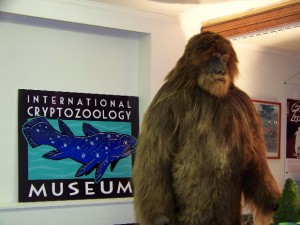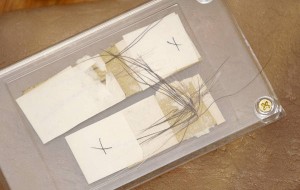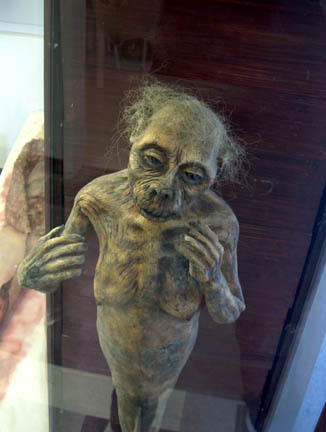April 2, 2011
![]()
This amazing review of the International Cryptozoology Museum is to be found in the Boston Sunday Globe for April 3, 2011.

Putting cryptozoology on display to the world
By Patricia Harris and David Lyon

Globe Correspondent / April 3, 2011
PORTLAND, Maine — Believe it or not, it’s possible to walk into this building on the west side of downtown and completely miss the shaggy, 8-foot-tall representation of Bigfoot. Loren Coleman calls the phenomenon “hiding in plain sight,’’ and he suggests it partly explains the surprising discovery every few decades of previously unknown mega-fauna.
+++

If You Go
International Cryptozoology Museum
661 Congress St.
Portland, Maine
207-518-9496
www.cryptozoologymuseum.com
Wed-Sat 11 a.m.-5:00 p.m., Sun noon-4:00. Admission $5.
+++
Coleman has been called “the world’s leading living cryptozoologist’’ and the International Cryptozoology Museum that he opened in 2003 is probably the world’s only cryptozoology museum. “There are specialized museums,’’ he says, “like the two Loch Ness monster museums in Scotland and a few Bigfoot museums out West, but this is the only one dealing with the whole range of cryptids.’’
Most people agree that the term cryptozoology was coined by adventurer, naturalist, and author Ivan T. Sanderson to refer to the scientific study of “hidden animals,’’ creatures known to folklore or popular tradition but unverified by modern biology or zoology. Over the years the term has broadened from investigations of sea serpents, Yeti (the “abominable snowman’’), and Bigfoot to encompass supposed survivals of ancient animals and creatures far from their natural habitats. For example, the anecdotal evidence for panthers in the woods of northern Maine and woolly mammoths allegedly sighted in Siberia fall under the rubric of cryptozoology.

Hair gathered during Tom Slick’s expedition to Nepal in the 1950’s was DNA tested and came back “unknown.” Loren Coleman tells of how the hair belongs to a 4-foot tall variety of Yeti. Amber Waterman Photo.
Either Coleman or a docent gives every visitor to the museum a brief overview tour touching on some of the 2,000 objects, which range from “samples’’ of Yeti hair to fantasy film props to souvenir shop models of Nessie, the Loch Ness monster. We arrived deeply skeptical about the subject, and learned that we were not alone. “I’m a skeptically open-minded person,’’ Coleman says. “Being skeptical is an important part of cryptozoology.’’
Coleman likes to start his tour for crypto-newbies with the display case of “Animals of Discovery.’’ These are the legends that came true, like the giant squid of antiquity confirmed in 1865, according to a newspaper account. Or the mountain gorilla, which was so reclusive that it was not identified by European science until 1902. Coleman is taken with the okapi, a living fossil long reported by Pygmies in the Congo but not confirmed until 1901. Despite its stripes and vague resemblance to a zebra, the okapi is essentially a proto-giraffe. Even the popular giant panda was virtually unknown in the West until socialite Ruth Harkness brought one back from China in 1936.
But the most amazing discovery might be the coelacanth, a fish thought to have been extinct for 65 million years until one was hauled up from the Indian Ocean in 1938. Coleman’s museum displays a nearly 6-foot-long life-size replica of that 1938 specimen. Another coelacanth discovery inspired the 1954 horror movie “Creature from the Black Lagoon.’’ But a different slice of Hollywood set a young Coleman down the path to cryptozoology.
“When I was about 11, I saw a film called ‘Half-Human.’ It was about Yeti,’’ Coleman says. “Ultimately, I went into anthropology based on my driving interest in Bigfoot and Yeti.’’
It’s not surprising that Coleman has compiled a collection of artifacts from various Bigfoot and Yeti expeditions. He has copies of innumerable footprint casts — along with casts of his own children’s footprints that he uses as a teaching tool to show the differences in foot structure. He also has hair and fecal samples from one of Texas millionaire Tom Slick’s expeditions, and stills from the “Patterson film,’’ a 1967 amateur movie of an encounter with a female Bigfoot in a Northern California national forest.
Coleman points to an enlargement and computerized enhancement of the famous frame that appears to show the Bigfoot in mid-stride. Like other cryptozoologists, he has examined it closely for evidence of fraud. Signs of fur creasing and muscle tension in the calf of the creature (which would not happen with an ape suit) keep Coleman from writing off the home movie. “It’s not enough to say Bigfoot exists,’’ he says, “but it’s enough for us to remain open-minded.’’
He readily acknowledges the prevalence of hoaxes in cryptozoology, relating his own part in uncovering fake Bigfoot prints left around Northern California. “See the squared-off toe?’’ he says, showing a cast. “That’s diagnostic of a Ray Wallace hoax. There were hundreds of them.’’
The trick is to tell the serious from the hoax, and Coleman believes his background in social work helps. “I analyze the people involved in sightings,’’ he admits. “It’s all part of the investigation.’’
He also maintains a sense of humor, showing off a display case of hoax “specimens’’ of jackalopes (antlered jackrabbits), fur-bearing trout, and plastic models of Mexican goat-sucking monsters called chupacabras. “On investigation, the chupacabras all turn out to be wild dogs or coyotes,’’ he says. He displays other historic frauds, such as a model of P.T. Barnum’s “Feejee Mermaid’’ made for a Hollywood film, or a phony pterodactyl featured in a B movie. He even displays the November 2004 cover of the comic book “Swamp Thing’’ that shows a terrified Loren Coleman running from a Bigfoot.


The museum has two often-photographed Feejee Mermaids.
Such fame — or infamy — comes with the territory. With 35 books under his belt, Coleman is the leading chronicler of cryptozoology. He has advised such TV series as “Unsolved Mysteries,’’ originally on NBC, and A&E’s “Ancient Mysteries.’’ And he has paid special attention to Maine. A map on the museum wall pinpoints sightings of all sorts of cryptids, from black panthers to Bigfoot to the 19th-century accounts of “specter moose,’’ a sort of ghost critter. He has investigated at Loch Ness but says sea serpents could be much closer to home.
“There are 500 years of sea serpent legends in Casco Bay,’’ he says, noting the last sighting of what he calls “Cassie’’ was in 2007. “It hasn’t really caught on because no one has done T-shirts,’’ Coleman says drolly. “The Gloucester Sea Serpent has much more publicity.’’ He points to an 1819 newspaper article and a 1940s map.
Coleman honestly doubts that many cryptids will be proven real, though he would love to see better evidence for the Yeti “because that was my initial love.’’ More probable is that creatures could come from the water. He does not entirely dismiss the Loch Ness monster, but says, “I think there is much better evidence for a large fish-like creature in Lake Champlain.’’
After all, as Shakespeare had Hamlet declare, “There are more things in heaven and earth, Horatio, than are dreamt of in your philosophy.’’
Source. [Please note: Images have been added from the ICM’s collection to illustrate this article. As far as is known, the Sunday Globe article is without photographs.]

![]()
About Loren Coleman
Loren Coleman is one of the world’s leading cryptozoologists, some say “the” leading living cryptozoologist. Certainly, he is acknowledged as the current living American researcher and writer who has most popularized cryptozoology in the late 20th and early 21st centuries.
Starting his fieldwork and investigations in 1960, after traveling and trekking extensively in pursuit of cryptozoological mysteries, Coleman began writing to share his experiences in 1969. An honorary member of Ivan T. Sanderson’s Society for the Investigation of the Unexplained in the 1970s, Coleman has been bestowed with similar honorary memberships of the North Idaho College Cryptozoology Club in 1983, and in subsequent years, that of the British Columbia Scientific Cryptozoology Club, CryptoSafari International, and other international organizations. He was also a Life Member and Benefactor of the International Society of Cryptozoology (now-defunct).
Loren Coleman’s daily blog, as a member of the Cryptomundo Team, served as an ongoing avenue of communication for the ever-growing body of cryptozoo news from 2005 through 2013. He returned as an infrequent contributor beginning Halloween week of 2015.
Coleman is the founder in 2003, and current director of the International Cryptozoology Museum in Portland, Maine.
Filed under Bigfoot, Breaking News, Cryptotourism, CryptoZoo News, Cryptozoologists, Cryptozoology, Men in Cryptozoology, Merbeings, Museums, Pop Culture, Replica Cryptia, Reviews, Sasquatch